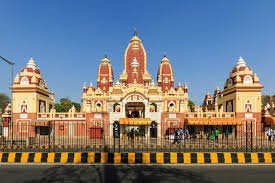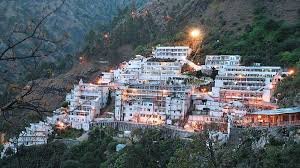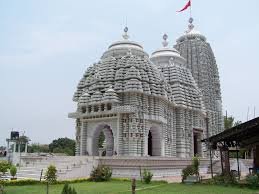Introduction
In the heart of Delhi, surrounded by lush gardens and vibrant city life, stands the Laxminarayan Temple, popularly known as Birla Mandir. Dedicated to Lord Vishnu and Goddess Lakshmi, this magnificent temple is not only a place of worship but also a symbol of India’s rich cultural heritage and architectural brilliance. Established by the Birla family, the temple is a sanctuary of peace and devotion, drawing visitors from all walks of life. read more about Laxminarayan Temple Delhi.
Whether you are a devotee seeking blessings, a traveler fascinated by architectural wonders, or someone looking for a tranquil escape, Laxminarayan Temple offers an experience that is both spiritually uplifting and visually stunning.
History and Origins of Laxminarayan Temple
Vision of the Birla Family
The Laxminarayan Temple was constructed by the industrialist Baldeo Das Birla and his son Jugal Kishore Birla in 1939. The temple was inaugurated by Mahatma Gandhi, who insisted that the temple should be open to people of all castes and religions, thereby promoting the ideals of equality and unity.
Furthermore, the Birla family aimed to create a temple that would stand as a testament to India’s spiritual traditions while embracing the modern architectural sensibilities of the time. As a result, Laxminarayan Temple has become a cherished landmark in Delhi, known for its inclusivity and grandeur.
Architectural Grandeur of Laxminarayan Temple
A Blend of Tradition and Modernity
The Laxminarayan Temple is an architectural masterpiece that combines traditional Hindu temple design with modern construction techniques. Built using red sandstone and white marble, the temple exudes an aura of divine elegance. The main shrine houses the beautifully adorned idols of Lord Vishnu and Goddess Lakshmi, symbolizing prosperity, wealth, and harmony.
Key Architectural Features
- Main Sanctum:
- The primary sanctum is dedicated to Lord Vishnu and Goddess Lakshmi, depicted in a majestic standing posture.
- The altar is intricately carved with scenes from Hindu scriptures, adding to its spiritual significance.
- Additional Shrines:
- The temple complex also houses shrines dedicated to Lord Shiva, Goddess Durga, and Lord Ganesha, allowing devotees to offer prayers to multiple deities.
- Towering Shikharas:
- The temple’s shikharas (spires) rise high into the sky, symbolizing the connection between the earth and the divine.
- Adorned with beautiful carvings, these shikharas are a visual delight, especially when illuminated in the evening.
- Beautiful Gardens and Fountains:
- The temple is surrounded by well-maintained gardens, featuring vibrant flowers, fountains, and statues that create a serene environment.
- As you walk through these gardens, the tranquil setting enhances your spiritual experience, making it a perfect place for meditation and reflection.
Spiritual Significance and Daily Rituals
Laxminarayan Temple is a hub of spiritual activities, offering devotees a place to connect with the divine. The temple holds daily aartis (rituals with lamps) and bhajans (devotional songs), creating an atmosphere of devotion and peace.
Daily Worship and Offerings
- Morning and Evening Aartis: The temple hosts two major aartis every day, drawing large crowds of devotees.
- Offerings: Devotees bring flowers, sweets, and coconuts as offerings to the deities, seeking their blessings for prosperity and well-being.
- Chanting and Meditation: The temple encourages visitors to chant mantras and meditate, enhancing their spiritual connection.
Festivals and Celebrations
The Laxminarayan Temple comes alive during Hindu festivals, with special prayers, decorations, and cultural programs.
Major Festivals Celebrated
- Diwali:
- The temple is adorned with thousands of diyas (oil lamps), creating a mesmerizing display of lights.
- Devotees gather to perform Lakshmi Pooja, seeking the goddess’s blessings for wealth and prosperity.
- Janmashtami:
- Celebrating the birth of Lord Krishna, the temple hosts cultural performances, kirtans, and midnight prayers.
- Holi:
- The festival of colors is celebrated with traditional rituals and devotional singing.
- Navratri:
- Nine days of special prayers and cultural programs dedicated to Goddess Durga and Goddess Lakshmi.
Social and Cultural Impact of Birla Mandir
Beyond its religious significance, Laxminarayan Temple serves as a center for social and cultural activities. The temple organizes educational programs, charitable activities, and cultural events, fostering a sense of community and social responsibility.
Interfaith Harmony
Laxminarayan Temple promotes interfaith harmony by welcoming people from all religions and backgrounds. As a result, it stands as a symbol of unity and inclusivity in a diverse city like Delhi.
How to Reach Laxminarayan Temple
The temple is conveniently located in Central Delhi, making it easily accessible by various modes of transportation.
- The nearest metro station is R.K. Ashram Marg (Blue Line), from where the temple is just a short walk away.
- Several DTC buses operate to and from Connaught Place and Karol Bagh, both close to the temple.
- You can also hire a cab or drive your own vehicle, as ample parking space is available near the temple.
- Auto-rickshaws and cycle rickshaws are readily available from nearby markets and metro stations.
Entry Fee and Visiting Hours
- Entry Fee: Free for all visitors.
- Visiting Hours:
- Summer: 4:30 AM – 1:30 PM & 2:30 PM – 9:00 PM
- Winter: 4:30 AM – 1:30 PM & 2:30 PM – 8:00 PM
- Open: All days of the week.
Nearby Attractions to Explore
When visiting Laxminarayan Temple, you can also explore these nearby attractions:
- Gurdwara Bangla Sahib: A significant Sikh pilgrimage site known for its serene Sarovar (water tank).
- Jantar Mantar: An astronomical observatory built by Maharaja Jai Singh II, showcasing ancient scientific instruments.
- Connaught Place: A bustling commercial hub with shopping outlets, restaurants, and cafes.
- India Gate: A historic war memorial, perfect for an evening stroll and family outings.
Why You Should Visit Laxminarayan Temple
- Experience Divine Peace and Serenity: The temple’s serene environment offers a sanctuary for meditation and reflection.
- Admire Architectural Brilliance: The fusion of traditional and modern architecture makes it a visual delight.
- Participate in Vibrant Festivals: Witness grand celebrations during major Hindu festivals like Diwali and Janmashtami.
- Embrace Cultural Unity: The temple promotes inclusivity and interfaith harmony, welcoming people of all backgrounds.
- Explore Central Delhi: The temple’s prime location allows easy access to many historic and cultural landmarks.
Conclusion
The Laxminarayan Temple (Birla Mandir) is more than just a temple—it is a beacon of faith, unity, and cultural heritage. From its divine idols and vibrant festivals to its lush gardens and architectural splendor, the temple provides a holistic experience for all who visit.
So, the next time you are in Delhi, make sure to visit Laxminarayan Temple. Whether you seek spiritual blessings or simply wish to admire its beauty, this temple promises an enriching experience that will leave you with lasting memories and a sense of peace.





